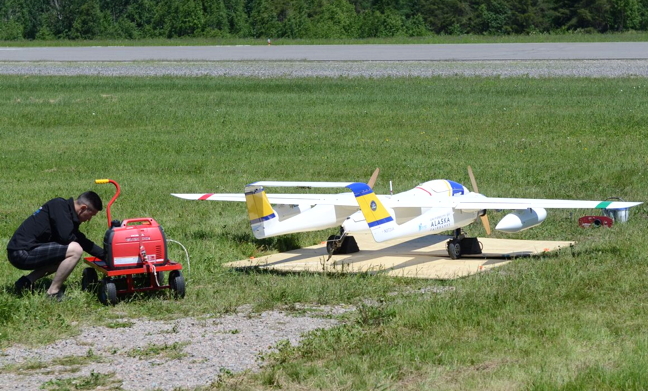Nunavut drone company lands contract to help shape Canada drone policy
An Iqaluit drone imagery company just won a two-year contract with Transport Canada to help formulate rules and regulations on how manned and unmanned aircraft might one day share airspace.
Arctic UAV, a small and recent start-up company, is poised to earn at least $300,000 over the course of the contract to test unmanned aerial vehicles in northern and southern locations, said UAV’s chief executive officer and chairperson, Kirt Ejesiak.

“We want to understand all the regulations that are in place. How do we safely integrate larger drones into airspace that civil, manned aviation, would also use,” Ejesiak told Nunatsiaq News.
“So this project with Transport Canada is really about establishing ground rules for commercial operators because right now, they don’t typically allow these drones to fly in airspace used by manned aviation.”
Arctic UAV, an Inuit-owned company which has five core staff, and which has trained eight drone operators over the past year, provides cutting edge remote aerial drone photography and video for the public and private sector.
Their operators are also northerners, Ejesiak said, which means they have experience on the Arctic land, ice and water. They can mobilize quickly to shoot in remote locations, he said, and they know what to expect from the sometimes unpredictable environment.
But the increasing use of private and commercial drones has put pressure on Transport Canada to come up with some rules to ensure safety in Canadian skies, Ejesiak said.
Currently, with some exemptions, drones cannot operate within five nautical miles of an airport, Ejesiak said.
But Transport Canada wants to find a way to allow both to use the same airspace, under certain circumstances, by allowing drone operators to act as virtual “pilots” and be in contact with airport air traffic control.
This would involve allowing drones to fly “beyond visual line of sight” or BVLOS—and Arctic UAV is thrilled to be leading the way in terms of research, development and training in that area, Ejesiak said.
For this contract, Arctic UAV is partnering with experts in drone operations at the University of Alaska Fairbanks whose centre for UAV systems has been in operation for 16 years.
In an email to Nunatsiaq News, a Transport Canada spokesperson said Arctic UAV was chosen, “based on their experience in unmanned air vehicle operations in the Arctic and the fact they had access to an unmanned air vehicle that met the operational requirements for these test trials.”
That vehicle, the Griffon Aerospace’s SeaHunter, is a large, Class 2 airplane-shaped UAV that weighs between 250 to 300 pounds (113 to 136 kilograms).
Arctic UAV recently tested the SeaHunter in Alma, a certified UAV test region in Quebec’s Saguenay region, north of Québec City.
Ejesiak said the test went well and was significant because of the involvement of UAV Arctic’s newest young pilot, Iqaluit’s Keane Sudlovenick, whom they hired about a year ago.
Sudlovenick, 19, has a natural gift for computers and technology, Ejesiak said, and proved himself capable on a tourism contract the company did previously with the Nunavut government.
“He’s probably the youngest, most experienced UAV pilot anywhere in the North,” Ejesiak said.
“He’s a young guy, a go-getter, active in the community. He found that [tourism] project interesting. He found UAVs to be exciting. It was a match made in heaven. We decided, how cool would it be to get a young guy, fresh out of high school, train him on how all the UAV systems work? And he’s been doing great.”
With training money from the Kakivak Association and the Government of Nunavut, they’ve sent Sudlovenick on drone courses in southern locations and they are now mentoring him to be an expert in the field.
“We think there’s a real opportunity for young people in the North,” Ejesiak said.
Arctic UAV is now preparing for test flights in a second southern location, in Foremost, Alta, and will then begin planning test flights for next year, likely in Iqaluit and Inuvik, Ejesiak said.
For a small company that only started up 18 months ago, this contract is a big deal, Ejesiak said, and a chance to gain expertise and a national reputation in the field.
“We’re really setting up a small airline, technically,” Ejesiak said.
“We see this is a real opportunity for growth for us in Iqaluit. We want to be able to branch into other communities in Nunavut. We see a real need, and a real hunger for these services, that local people can provide.”